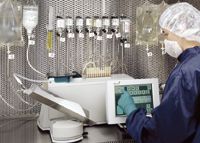Once error-prone, TPNs now safer with new system
Reducing medical errors during total parenteral nutrition (TPN) processes has been a 25-year challenge for Robert Poole, Pharm.D., director of pharmacy, and his colleagues at Lucile Packard Children's Hospital (LPCH), Stanford University Medical Center.

It was in 1981 that Poole and John Kerner, M.D., a pediatric gastroenterologist at LPCH, began collaborating on issues affecting premature infants receiving TPN. It was a procedure begging for errors, Poole said. "TPN orders were handwritten and hand calculated. We had to decipher in the pharmacy what the physician had attempted to order, then make up the solution correctly."
The first step toward reducing errors was to eliminate calculation errors. "The average TPN solution has about 16 components, and nine of them can be fatal if given in the wrong amount," Poole explained. Computerizing the calculation process was the answer, and Nick Mackenzie, M.D., an anesthesiologist with computer programming knowledge, was added to the team. The program to perform the calculations, evolving through various computer languages, is now Windows-based. Today, the calculation and labeling errors have basically been eliminated.
"Some of these babies weigh one to two pounds-even less. Too much fluid could throw them into congestive heart failure, open up their fetal circulation, and really distress them."
In 2003 the team built safety features into the program, establishing minimum and maximum doses for all components to eliminate the possibility of generating a toxic solution. As the order is being put into the computer, the program disallows anything potentially harmful. The result has been a decrease in adverse drug events of over 70%.
A big step forward was hooking the program up to a BAXA automated compounder in 2004. Now the computer generates a bar-coded file, which the compounder reads and then makes the solution. This virtually eliminates compounding errors. With manual compounding, Poole said, "a pharmacy technician could draw up the wrong volume for any of those 16 components. In most pharmaceuticals, the error rate is 10%. But the automated compounder has around a 1% error rate in the volumes that are delivered." In addition, the compounder is a closed system, which reduces the potential for infection and touch contamination.
The automated compounder reduced staff time from around 20 hours of compounding a day to five hours, and has reduced repetitive motion injuries from drawing large syringes with large volumes many times during the day. The labor saved has also improved turnaround time between physician orders and getting the solution to the patient. And because the computer software provides immediate feedback, the number of times the pharmacy has to contact physicians to get orders changed has decreased almost 75%.
To ensure that the TPN program will outlast its makers, a private company (Monterey Medical Solutions) was formed to make the now-named TPN Medsoft available to other hospitals. The program is not limited to pediatrics; in fact, LPCH has used it for its adult home TPN patients as well.
The next step at LPCH will be to add computerized physician order entry to the TPN program. This is targeted for early 2006. Poole feels that when that's in place, his team will have met all aspects of its original challenge. "I think we've thought of just about everything. The program has made a very complex therapy relatively simple, and I think we've pretty much nailed the safety issues at this point."
THE AUTHOR is a writer based in New Hampshire.